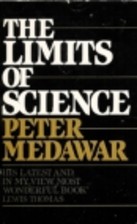“A successful argument for science being the paradigm of rationality must be based on the demonstration that the presuppositions of science are preferable to other presuppositions. That demonstration requires showing that science, relying on these presuppositions, is better at solving some problems and achieving some ideals than its competitors. But showing that cannot be the task of science. It is, in fact, one task of philosophy. Thus the enterprise of justifying the presuppositions of science by showing that with their help science is the best way of solving certain problems and achieving some ideals is a necessary precondition of the justification of science. Hence, philosophy, and not science, is a stronger candidate for being the paradigm of rationality.” – Nicholas Rescher, The Limits of Science
C.S. Lewis contended that scientists, too, have “noses of wax” to be twisted whichever ways their predilections compel them. Lewis summarized the challenge faced by scientists in this excerpt from Mere Christianity:
“Science works by experiments. It watches how things behave. Every scientific statement in the long run, however complicated it looks, really means something like, ‘I pointed the telescope to such and such a part of the sky at 2:20 a.m. on January 15th and saw so-and-so,’ or, ‘I put some of this stuff in a pot and heated it to such-and-such a temperature and it did so-and-so.’ Do not think I am saying anything against science: I am only saying what its job is. And the more scientific a man is, the more (I believe) he would agree with me that this is the job of science – and a very useful and necessary job it is too. But why anything comes to be there at all, and whether there is anything behind the things science observes – something of a different kind – this is not a scientific question. If there is ‘Something Behind,’ then either it will have to remain altogether unknown to men or else make itself known in some different way.” [Mere Christianity]
As John Stonestreet has noted, “C. S. Lewis was no opponent of science. But he was an opponent of abusing science….the problem, as C. S. Lewis would have pointed out, is that science alone can’t tell us what constitutes a “better world.” That’s a question of ought, and science only tells us what is.
Enter the “The Abolition of Man,” a book whose title summarizes Lewis’s biggest critique of scientism. He writes that many in his day who expected science to conquer nature and engineer a better humanity were actually enslaving themselves to the worst aspects of human nature. In doing so, he argued, advocates of scientism discarded what really sets human beings apart from animals—the ability to know and do what’s right. They were, as he put it, abolishing man.
And to this day, scientists who fail to recognize a moral order other than what will bring the most people the most happiness end up reducing us all to being less than human.
It’s a crucial point, and fortunately for us, Lewis didn’t confine it to his scholarly essays. Throughout his most beloved fiction, we find depictions of scientists who, seeking to transcend Christian morality, degenerate into fiends. Whether it’s the conniving Uncle Andrew from “The Magician’s Nephew,” the ghastly Unman from “Perelandra,” or the National Institute for Coordinated Experiments in “That Hideous Strength,” Lewis filled his novels with parables illustrating the lesson he spelled out in “Abolition of Man.”
Right and wrong, he insisted, aren’t negotiable—not even in the name of science…it’s what teaches us how to use science, and what true human flourishing looks like.”
—
Because scientists can confuse their own beliefs and opinions with the verifiable results of their methodological studies, free-thinking students must learn to distinguish between what is verifiable by the realm of natural science, and what is beyond its limits. Asking good questions and knowing the difference between empirical and non-empirical subjects – between the physical and the metaphysical – can keep us clear-headed.
References
For future reference, following are the endnotes for the material from the Baumgardner article used throughout this experience:
- Wolfs, F. 1996. Introduction to the scientific method. Physics Laboratory Experiments, Appendix E, Department of Physics and Astronomy, University of Rochester.
- Baumgardner, J. 2008 (in press). Language, Complexity, and Design. In Seckback, J. and R. Gordon (eds.), God, Science and Intelligent Design. Singapore: World Scientific.
- Sanford, J. 2005. Genetic Entropy and the Mystery of the Genome. Lima, NY: Elim Publications.
- Sanford, J., J. Baumgardner, et al. 2007. Using computer simulation to understand mutation accumulation dynamics and genetic load. In Shi, Y. et al. (eds.), ICCS 2007, Part II, Lecture Notes in Computer Science, Vol. 4488. Berlin and Heidelberg: Springer-Verlag, 386-392.
- Sanford, J., J. Baumgardner, et al. 2008 (in press). Numerical simulation falsifies evolutionary genetic theory. Proceedings of the Sixth International Conference on Creationism. San Diego, CA: ICR.
- Kimura, M. 1979. Model of effectively neutral mutations in which selective constraint is incorporated. Proceedings of the National Academy of Sciences. 76: 3440-3444.
- Kondrashov, A. S. 1995. Contamination of the genome by very slightly deleterious mutations: why have we not died 100 times over? Journal of Theoretical Biology. 175: 583-594.
- Austin, S. A. 1994. Grand Canyon: Monument to Catastrophe. Santee, CA: ICR.
- Hawking, S. W. and G. F. R. Ellis. 1973. The Large Scale Structure of Space-Time. Cambridge: Cambridge University Press, 134.









